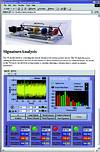New LabVIEW version instantly enables web-based measurements
20 November 2002
Electronics Technology

National Instruments' LabVIEW 6.1 graphical development environment for test, monitoring, and control applications, builds on the web capabilities of LabVIEW 6i by simplifying the creation of remote applications and integrating the latest technologies for XML and wireless communications.
This software makes it easier for engineers to control their applications from any commonly used web browser - anywhere in the world. In two mouse clicks, engineers can instantly embed their application's front panel in a web browser, reducing the time and costs typically associated with developing remote applications. This feature makes it possible for colleagues across the office or across the globe to connect to the same system and view an application in realtime. Engineers can also control hardware from a separate office or from home, increasing efficiency and reducing development costs.
In addition to the new tools that maximises the advantages of the web, LabVIEW 6.1 uses the latest commercial technologies to expand networking capabilities. The newest version works seamlessly with Windows XP that has increased networking features and enhanced stability. LabVIEW 6.1 also introduces wireless infrared data communications protocols, empowering engineers to create applications that communicate with wireless devices, such as PDAs. Import and export of XML-formatted data is also possible to integrate VIs with other web or database applications in the enterprise.
LabVIEW 6.1 expands on the measurement capabilities of LabVIEW 6i in terms of an increase the accuracy, efficiency, and speed of measurement and analysis. The point-by-point analysis libraries increase application performance and enhance realtime response acquisition and processing data a single point at a time at relatively high speeds, such as in closed-loop control applications. It also includes functions that increase fast Fourier transform (FFT) analysis speed by as much as 10 times over LabVIEW 6i. Event-driven programming also simplifies the development of sophisticated user interfaces.
NI is releasing the latest versions of the realtime module and the datalogging and supervisory control module. With this tightly integrated family of LabVIEW products, engineers can easily build targeted applications for measurement, monitoring, and control. The LabVIEW realtime module extends LabVIEW graphical development to enable creation of deterministic, realtime applications. The datalogging and supervisory control module is an ideal tool for distributed monitoring applications and now offers enhanced historical data management tools in addition to built-in features for monitoring applications.
Further reading:
140 W USB-C PD reference design
Altron Arrow
Electronics Technology
The design has a wide input range of 90 to 264 V AC, 50-60 Hz, and supports an output voltage range of 5 to 28 V (USB-PD 3.1 specification).
Read more...
Nanometre-precision piezo actuators
RS South Africa
Electronics Technology
TDK Corporation has announced two new piezo actuators that are characterised by a wide dynamic range, a high force-to-volume ratio, but with precision in the nanometre range.
Read more...
Webinar: The evolving electrification of the power distribution system
Infineon Technologies
Electronics Technology
New connected car functionality, along with the necessity to reduce the cost, weight and complexity associated with wire harnesses, has led to the transformation of the power distribution system in automotive engineering.
Read more...
Improved MnZn material for power conversion industry
Sivan Electronic Supplies
Electronics Technology
Cosmo Ferrites Ltd, a leading manufacturer of soft ferrites, has launched an improved version of CF295 for the power conversion industry.
Read more...
Common mode filter for automotive Ethernet
Avnet Abacus
Electronics Technology
TDK Corporation has announced the introduction of its new ACT1210E Series common mode filter for automotive Ethernet 10BASE-T1S.
Read more...
Energising the industrial edge
Electronics Technology
As if the drive to decarbonise energy as part of sustainability and climate change efforts was not enough, the recent rise in energy prices has brought into sharp contrast the need to re-examine how we generate, distribute, and consume electricity.
Read more...
Samsung begins chip production using 3 nm process technology
EBV Electrolink
Electronics Technology
The optimised 3 nm process with GAA architecture achieves 45% lower power usage, 23% improved performance and 16% smaller surface area compared to 5 nm process.
Read more...
Panasonic releases its updated touch-sensitive knob
Altron Arrow
Electronics Technology
Panasonic, in conjunction with Microchip, has launched an update to its existing Magic Knob, a capacitive knob ready for standard touch sensors for use in controlling automotive information displays.
Read more...
Microchip’s new IC to replace Hall effect position sensors
Altron Arrow
Electronics Technology
The LX34070 IC from Microchip is set to help accelerate the global move away from expensive and less accurate magnet-based solutions for safety-critical EV motor position monitoring.
Read more...
A brief history of HBTs
Conical Technologies
Electronics Technology
In 1947 the engineers at Bell Labs were tasked with developing a transistor. This development heralded the beginning of the semiconductor industry which changed the world forever. Transistors would have
...
Read more...


